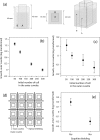Endogenous physical regulation of population density in the freshwater protozoan Paramecium caudatum
- PMID: 29062014
- PMCID: PMC5653844
- DOI: 10.1038/s41598-017-14231-0
Endogenous physical regulation of population density in the freshwater protozoan Paramecium caudatum
Abstract
Studies confirm physical long-range cell-cell communication, most evidently based on electromagnetic fields. Effects concern induction or inhibition of cell growth. Their natural function is unclear. With the protozoan Paramecium caudatum I tested whether the signals regulate cell density and are electromagnetic. Up to 300 cells/mL, cell growth in clones of this study is decreasingly pronounced. Using cuvettes as chemical barriers enabling physical communication I placed 5 indicator cells/mL, the inducer populations, into smaller cuvettes that stand in bigger and contained 50, 100, 200 or 300 cells/mL. Under conditions of total darkness such pairs were mutually exposed for 48 hours. The hypothesis was that indicator cells, too, grow less the more neighbor cells there are. The bigger inducer populations were in the beginning the less they grew. The indicator populations grew accordingly; the more cells they were surrounded by the less they grew. The suppressing neighbors-effect disappeared when inner cuvettes were shielded by graphite known to shield electromagnetic radiation from GHz to PHz, i.e. to absorb energy from microwaves to light. These are the first results demonstrating non-contact physical quorum sensing for cell population density regulation. I assume rules intrinsic to electromagnetic fields interacting with matter and life.
Conflict of interest statement
The author declares that they have no competing interests.
Figures

Similar articles
-
Aligning Paramecium caudatum with static magnetic fields.Biophys J. 2006 Apr 15;90(8):3004-11. doi: 10.1529/biophysj.105.071704. Epub 2006 Feb 3. Biophys J. 2006. PMID: 16461406 Free PMC article.
-
Changes in Paramecium caudatum (protozoa) near a switched-on GSM telephone.Electromagn Biol Med. 2011 Mar;30(1):57-66. doi: 10.3109/15368378.2011.566778. Electromagn Biol Med. 2011. PMID: 21554102
-
Survival of Paramecium caudatum at various pH values and under normoxic and hypoxic conditions.Pak J Biol Sci. 2008 Feb 1;11(3):392-7. doi: 10.3923/pjbs.2008.392.397. Pak J Biol Sci. 2008. PMID: 18817161
-
A long-term conservation tool for cell characteristics: cryopreservation of Paramecium caudatum.Protist. 2009 Aug;160(3):355-63. doi: 10.1016/j.protis.2009.03.002. Epub 2009 May 9. Protist. 2009. PMID: 19427813 Review. No abstract available.
-
Two emerging topics regarding long-range physical signaling in neurosystems: Membrane nanotubes and electromagnetic fields.J Integr Neurosci. 2015 Jun;14(2):135-53. doi: 10.1142/S0219635215300115. Epub 2015 May 11. J Integr Neurosci. 2015. PMID: 25962399 Review.
Cited by
-
Measuring the Human Ultra-Weak Photon Emission Distribution Using an Electron-Multiplying, Charge-Coupled Device as a Sensor.Sensors (Basel). 2018 Apr 10;18(4):1152. doi: 10.3390/s18041152. Sensors (Basel). 2018. PMID: 29642593 Free PMC article.
-
Bioluminescence and Photoreception in Unicellular Organisms: Light-Signalling in a Bio-Communication Perspective.Int J Mol Sci. 2021 Oct 20;22(21):11311. doi: 10.3390/ijms222111311. Int J Mol Sci. 2021. PMID: 34768741 Free PMC article. Review.
-
Biofield Frequency Bands-Definitions and Group Differences.Glob Adv Health Med. 2020 Dec 24;9:2164956120982568. doi: 10.1177/2164956120982568. eCollection 2020. Glob Adv Health Med. 2020. PMID: 35392431 Free PMC article.
-
The Double-Aspect of Life.Biology (Basel). 2018 May 7;7(2):28. doi: 10.3390/biology7020028. Biology (Basel). 2018. PMID: 29735890 Free PMC article.
-
Towards the Idea of Molecular Brains.Int J Mol Sci. 2021 Nov 1;22(21):11868. doi: 10.3390/ijms222111868. Int J Mol Sci. 2021. PMID: 34769300 Free PMC article. Review.
References
-
- Gurwitsch, A. & Gurwitsch, L. Das Problem der Zellteilung physiologisch betrachtet in Monographien aus dem Gesamtgebiet der Physiologie der Pflanzen und der Tiere11 (eds Gildmeister, M., Goldschmid, R., Neuberg, C., Parnas, J. & Ruhland, W.) 1–221 (Springer, 1926).
Publication types
MeSH terms
LinkOut - more resources
Full Text Sources
Other Literature Sources
Medical

